Belgium has been known for the quality of it’s marbles since antiques times. Two main types of marbles were there exploited : uniform dark grey and black materials or polychroms red, grey or pink marbles.
Due to the high purity of it’s deposits, it’s unclear even today which were the most antique quarries of black marbles. Quarrying occured all-over south western Belgium in an area known as “Wallonie“ around the cities of Namur, Dinant, Tournai, Basecles, Theux and Mazy/Golzinne.
In antique times, black siliceous stones were originally sought for their quality of gold testing. As many different coinage were exchanged, money changers often needed to test the purity of the gold a foreign coin could contain. This testing was done by passing the coin on a pure black siliceous stone slab or “Paragone“. Depending on the gold contain, the trace left was more ore less yellow and compared to trace of coinage from which the gold contain was known.
The name “Paragone del Belgio“ or “Diaspro del Belgio“ originated from this use of the belgium black stones during roman empire.

First evidences of belgium black marble use in architecture were also discovered by archaelogists in villas dating the roman occupation. It seems to have been limited to local constructions and not exported. Evidences of it’s uses included wall claddings, “opus sectile“ and mosaics including exotic species of marbles.
Exemple of Opus sectile Second quarter of IV secolo a.c. - Giunio Basso Basilic – Roma.
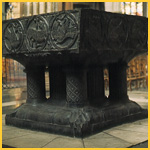
It then became a crucial material for religious architecture during early middle-age were it went use for floorings, tombstones and monuments, frequently with colored inlays, but also carved altars and sculpture.
Tournai Noir belge carved church altar – Termonde Church - Belgium.

Black marbles begun to be exported at that period all over western europe seashores. They reached Portugal to Scandinavia through rivers and sea shipping.
Gothic style then broadly used the black marbles again in floorings but also in massive elements like staircases, columns of all sizes and shapes, altars and royal tombstones in contrast with white marble or alabaster sculptures.
King Frederick II tombstone in Roskilde Cathedral (Denmark).
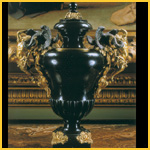
Renaissance then introduces a change. Emphatizing the antique greek and roman classical art of marble sculpture and opus sectile technique it introduced a major request of colored marbles as reds or pinks.
Paragone del belgio Marble Urn with golden bronze cherub handles embracing silver swan.
Work by Massimiliano Soldani Benzi (1689-1693)
Palazzo Pitti Florence.
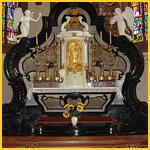
Carved black marbles kept being largely used in churches, religious and funerary architecture. During early XVIIth century in Belgium, the religious sculpture craft became the speciality of Namur and Golzinne regions where architects would come from distant areas to have their works being done (ex : De Nole from Antwerp city).
Exemple of baroque altar carved out Noir belge marble – St Eustache Church – Zichem – Belgium.
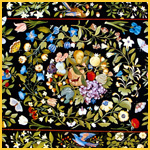
In Italy, the “Opeficio delle pietre dure“manufacture, officially founded in 1588 by Ferdinand I de Medici in Florence supplyied the growing demand of artistic artifacts of the court. It quickly specialized in semi-precious stone inlays of floral design inserted on top of “Noir belge“ marbles and it’s productions begun to be exported to the major european courts.
Exemple of Noir belge semi-precious stone inlaid table top.
Thanks to the diplomatic and trade relashionships, the fashion for these precious artifacts quickly resulted in the creation of several specialized manufactures often under italian masters (Naples, Vienna, Praga, Madrid)

They all gave birth to a tradition of use of the “Noir belge“for base of inlaid and are still today operating in the field of jewelry and semi-precious stone item crafting.
In early XVIIth, the fascination for the “Pietra dura“ art radiated as far as India where Shah Jahan hired italian artists for the decoration of the Taj Mahal as the tomb of his beloved wife. As a result “Noir belge“marbles are present in the inlays that covers the white marble claddings of this wonder of architecture.
Taj MahalWhite mable and Noir belge inlaid cladding.
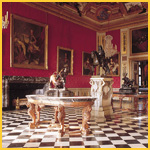
XVIIIth introduced many diversification in the sources of marbles, their processing and polishing. As it happened, marble architecture in Belgium became more sophisticated in it’s detail, conception and realization and also more accessible for private property. Black marbles went actively used in chesslike floorings in contrast with white marble and pure black baroque marble fireplaces begun a large distribution in the neightbouring countries. Golden bronzes become frequently mixed with black marble elements.
Vaux le Vicompte Royal Castle – France.
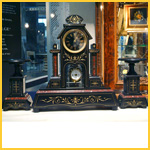
After French Revolution and during Empire the black marbles went largely used in furnitures with exotic woods and an industry of black marble clock even emerged.
Exemple of Noir belge Clock – Merbes-Sprimont Collection.

Neo-classic, baroque and “rocaille“style fireplaces continued to be an important market for belgian marbles (excellent exemples in places likes Louvre, Compiegne and Fontainebleau castles in France, Arenberg palace staircase in Brussels, done by Merbes-Sprimont company).
Exemple of Rocaille style fireplace carved out Noir belge.
Art Deco discovered in beginning of the XXth new uses for the black marbles but their fashion were abruptly halted during second world war and most quarries were shut in consequence of the war.
Heir of this prestigious history of Art and Architecture, our quarry re-opened in underground operation in 1928 after XIXth century surface quarrying. Golzinne is today the only quarry left in Belgium exploiting the original “Noir belge“marble.

